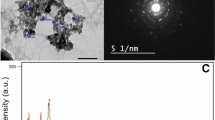Abstract
The purpose of this 42-day study was to investigate the effects of dietary excess vanadium on spleen growth and lesions by determining morphological changes and cell cycle of spleen. Four hundred twenty 1-day-old avian broilers were divided into six groups and fed on a corn–soybean basal diet as control diet or the same diet amended to contain 5, 15, 30, 45, 60 ppm of vanadium supplied as ammonium metavanadate. When compared with that of control group, the relative weight of spleen was significantly raised in 5- and 15-ppm groups, but depressed in 45- and 60-ppm groups. The gross lesions of spleen showed obvious atrophy with decreased volume and pale color in 45- and 60-ppm groups. Histopathologically, lymphocytes in splenic corpuscle and periarterial lymphatic sheath were variously decreased in number in 30-, 45-, and 60-ppm groups. The percentage of static phase (G0/G1) was significantly decreased, and the percentage of synthesis period (S) phase and the proliferating index (PI) were significantly increased in 5- and 15-ppm groups. The percentage of G0/G1 phase was significantly increased, and the percentage of mitotic phase (G2 + M), S phase, and PI significantly decreased in 45- and 60-ppm groups. These results suggested that dietary excess vanadium (45 and 60 ppm) could inhibit growth of spleen and induce lesions in spleen in chicken.



Similar content being viewed by others

References
French RJ, Jones PJH (1993) Role of vanadium in nutrition: metabolism, essentiality and dietary consideration. Life Sci 52(4):339–346
Nielsen FH (1990) New essential trace elements for the life sciences. Biol Trace Elem Res 26–27(1):599–611
Uthus EO, Nielsen FH (1990) Effect of vanadium, iodine and their interaction on growth, blood variables, liver trace elment and thyroid status indices in rats. Magnes Trace Elem 9(4):219–226
Anke M, Groppel B, Gruhn K et al (1989) The essentiality of vanadium for animals. In: Anke M, Baumann W, Braunlich H et al (eds) 6th International Trace Elment Symposium, vol 1. Friedrich- Schiller-Universitat, Jena, pp 17–27
Duckworth WC, Solomon SS, Liepnieks J et al (1998) Insulin-like efects of vanadium in isolated rat adipocytes. Endoerinology 122:2285–2289
Crans DC, Smee JJ, Gaidamauskas E et al (2004) The chemistry and biochemistry of vanadium and the biological activities exerted by vanadium compounds. Chem Rev 104(2):849–902
Domingo JL (2002) Vanadium and tungsten derivatives as antidiabetic agents. Biol Trace Elem Res 88(2):97–112
Norgaard A, Kjeldsev K, Hansen O et al (1983) A simple and rapid method for the determination of the number of H3-ouabain binding sites in biopsies of skeletal muscle. Biochem Biophys Res Commun 111(1):319–325
Bahdan RN (1984) Mechanisms of action of vanadium. Annu Rev Pharmacol Toxicol 24:501–507
Schmitz W, Scholz H (1982) Effect of vanadium in the +5, +4 and +3 oxidation states on cardiac force of contraction, adenylate cyclase and (Na+, K+)-ATPase activity. Biochem Pharmacol 31(23):3853–3860
Bishayee A, Chatterjee M (1995) Time course effects of vanadium supplement on cytosolic reduced glutathione level and glutathione S-transferase activity. Biol Trace Elem Res 48(3):275–285
Liochev SI, Fridovich I (1990) Vanadate-stimulated oxidation of NAD(P)H in the presence of biological membranes and other sources of O −2 . Arch Biochem Biophys 279(1):1–7
Wang J, Jin G, Youfang Gu (2006) Effects of vanadium on development of immune organs in broilers. Vet Sci China 37(7):578–582
Qureshi MA, Hill CH, Heggen CL (1999) Vanadium stimulates immunological responses of chicks. Vet Immunol Immunopathol 68(1):61–71
Dinoeva S (1982) Immuno-morphological evaluation of the effect of trace elements on experimental atherosclerosis. Eksp Med Morfol 21(3):130–136
Domingo JL, Llobet JM, Tomas JM et al (1985) Short-term toxicity studies of vanadium in rats. J Appl Toxicol 5(6):418–421
Cui H, Fang J, Peng X (2003) Pathology of the thymus, spleen and bursa of Fabricius in zinc-deficient ducklings. Avian Pathol 32:257–262
Fisher DE (2001) The p53 tumor suppressor: critical regulator of life & death in cancer. Apoptosis 6(1–2):7–15
Acknowledgment
The study was supported by the program for Changjiang scholars and innovative research team in university (IRT 0848) and the key program of Education Department and Scientific Department of Sichuan Province (09ZZ017).
Author information
Authors and Affiliations
Corresponding author
Rights and permissions
About this article
Cite this article
Cui, W., Cui, H., Peng, X. et al. Dietary Excess Vanadium Induces Lesions and Changes of Cell Cycle of Spleen in Broilers. Biol Trace Elem Res 143, 949–956 (2011). https://doi.org/10.1007/s12011-010-8938-0
Received:
Accepted:
Published:
Issue Date:
DOI: https://doi.org/10.1007/s12011-010-8938-0


